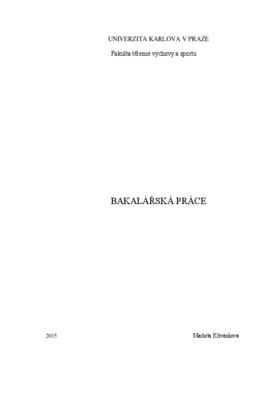Případová studie: Efektivita kompenzačního programu zaměřeného na redukci svalové dysbalance typu horní zkřížený syndrom.
Case study: The effectiveness of the compensation program aimed at reducing muscle imbalance type upper crossed syndrome.
bachelor thesis (DEFENDED)

View/
Permanent link
http://hdl.handle.net/20.500.11956/65132Identifiers
Study Information System: 134015
Collections
- Kvalifikační práce [8840]
Author
Advisor
Referee
Vařeková, Jitka
Faculty / Institute
Faculty of Physical Education and Sport
Discipline
Physical Education and Sport
Department
Information is unavailable
Date of defense
5. 5. 2015
Publisher
Univerzita Karlova, Fakulta tělesné výchovy a sportuLanguage
Czech
Grade
Excellent
Keywords (Czech)
vadné držení těla, hluboký stabilizační systém, fázické a posturální svalyKeywords (English)
pure posture, deep stabilization system, phasic and tonic musclesNázev: Případová studie: Efektivita kompenzačního programu zaměřeného na redukci svalové dysbalance typu horní zkřížený syndrom. Cíle: Vytvoření teoretického přehledu s kompenzačním programem v rozsahu 10 týdnu, který má za úkol zjistit efekt připravené intervence. Metody: Práce má povahu případové studie. Případové studie umožňují detailně vhlédnout do problematiky a porozumět jí. Pro sběr dat byly použity metody hodnocení držení těla aspekcí, svalový test podle Jandy, test na hlubokou stabilizaci páteře podle Koláře a goniometrické měření rozsahu pohybu v kloubech. Výsledky: Po desetitýdenní intervenci bylo dosaženo zlepšení v držení těla především v oblasti zvětšené hrudní kyfózy, kterou se podařilo zredukovat. U kloubní pohyblivosti měřené goniometricky došlo ke zlepšení rozsahu pohybu o 27%, nejvýraznější rozdíl byl v extenzi hrudní páteře a to o 213% oproti vstupnímu měření. Zvýšení flexibility bylo též možné pozorovat i při svalovém testu, kde došlo k pozitivnímu ovlivnění téměř všech kompenzovaných svalů. Současně se podařilo potvrdit hypotézu, že aktivace hlubokého stabilizačního systému má vliv na držení těla. Klíčová slova: vadné držení těla, hluboký stabilizační systém, fázické a posturální svaly.
Title: Case study: The effectiveness of the compensation program aimed at reducing muscle imbalance type upper crossed syndrome. Objectives: Creating a theoretical overview of the compensation program in the range of 10 weeks, which is required to determine the effect of intervention ready. Methods: The study has a form of a case study. Case studies allow better explore into the issue and help to understand it. For data collection methods were used assessment of posture by view, muscle testing according to Janda, the deep stabilizing of the spine test by Kolář and goniometric measurement range of motion in joints. Results: After a ten-week intervention was achieved to improvements in posture, especially in the area of enlarged thoracic kyphosis, which has been reduced. In the joint mobility measured goniometric was improved range of motion by 27%, the most striking difference was in the extension of the thoracic spine (about 213% compared to the input measurements). Increasing flexibility was also observed in the muscle test, where there was a positive effect on almost all compensated muscles. At the same time was confirm the hypothesis that activation of the deep stabilization system has an influence on the posture. Keywords: pure posture, deep stabilization system, phasic and postural muscles.
